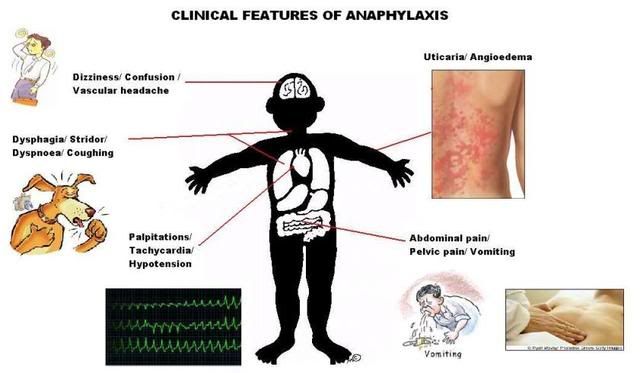

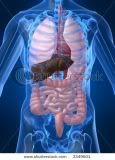

|
Friday, February 6, 2009 Y 8:06 PM Question 2 Explain anaphylaxis with the clinical features, mechanisms involved in causation and its management. Clinical Features of Anaphylaxis Y 7:01 PM Mechanisms involved in Anaphylaxis Anaphylaxis occurs when immunoglobulin E (IgE), which is produced by the body, reacts to protein which derived from our food or to certain type of drug. IgE stick to the cells in the body that release substances which affect blood vessels and air passages. The presence of the protein on the IgE on the cells leads to the release of these substances which in turn relaxes the blood vessels. These blood vessels become leaky and swell, lowering the blood pressure. In addition, breathing passages get narrowed. Anaphylaxis can be triggered by a particular allergen, mainly from food, medicine, insect sting, latex and even unknown cause. Exercising can cause exercise-induced anaphylaxis. Food Food allergy is a very common case of anaphylaxis. Research has showed that out of 5.4 to 7 million Americans who have food allergies, about 3 million are allergic to nuts alone. Food allergy has become an increasing concern that can result in around 125 deaths annually in United States. A simplified definition of food allergy means that when a person’s immune system reacts to food protein, which acts as a dangerous foreign substance, it will strengthen the body by developing IgE antibodies. Medicine Allergic reactions to medications can also cause anaphylaxis. Such allergens include penicilin, sulfa antibiotics, allopurinol and muscle relaxants. Most deaths from fatal anaphylaxis in the US are known to be caused by penicillin. Insect Sting Insects stings can trigger allergic reactions. Such insects include bees, wasps, hornets, yellow jackets and ants. When a person is bitten or stung by these insects, there can be two reactions; a normal response and anaphylaxis. A normal response can involve swelling, redness and pain at or around the site of the sting. Anaphylaxis could result from swelling of the throat or tongue, breathing difficulties, dizziness, severe headache, nausea, stomach cramp, diarrhea, rapid fall in blood pressure, shock, and also loss of consciousness. These symptoms should be noted as it could lead to deadly anaphylaxis within 1 to 2 minutes. Latex Latex allergy occurs when there is a systemic allergic sensitivity to the proteins present in natural rubber latex(NRL). Once there is exposure to NRL, subsequent exposures would worsen this sensitivity. Examples of materials that contain latex are car tires, rubber bands, carpet backing, hospital/dental equipment and more commonly latex gloves, balloons and condoms. Severe cases can cause death. Idiopathic Anaphylaxis A type of anaphylaxis which is triggered by unknown cause. Exercise – Induced Anaphylaxis Exercise – Induced Anaphylaxis is a physical allergy. The studies of this allergy are still on research. However, it has been found that certain medications such as aspirin or food taken before sports will increase the percentage of getting exercise – induced anaphylaxis. Individuals at risk are those with personal history or family atopy1. 1Atopy is the increased tendency seen in some individuals to produce IgE antibodies to innocuous substances. There are 2 major groups in the causes of anaphylaxis. IgE mediatied IgE will then stick to the cells, such as mast cells and basophils, so that they can be prepared to react when the allergen (food protein) is reintroduced. Once the exposure occurs, the mast cells will release mediators which includes histamine, leukotriene C4, prostaglandin D2 and tryptase in the tissues around the cells. This reaction causes the immediate onset of elevated secretion of mucus from mucous membranes, increased swelling of bronchial smooth muscle and a decrease in blood pressure. Also, making the breathing passage to decrease its width. Non-IgE mediated (“anaphylactoid” reactions) This reaction does not need an IgE immune reaction. It is usually caused by immediate exposure of mast cells and basophils. The same mediations are then released, producing the same effects. A simplified diagram of IgE mediated reaction 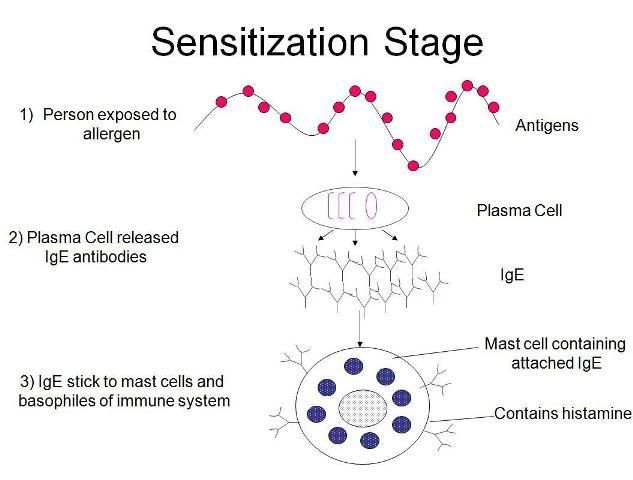 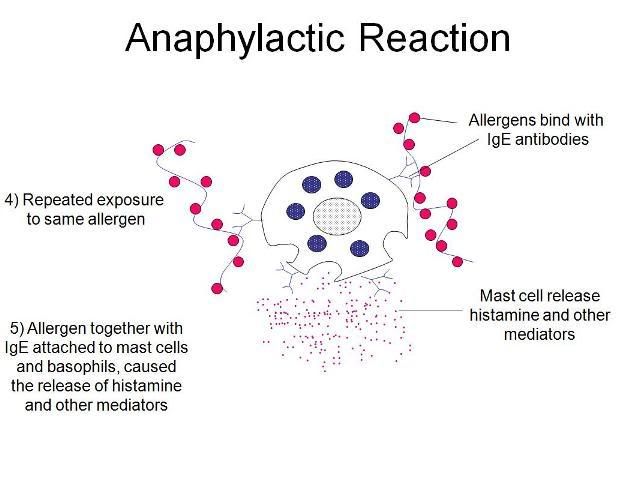 In conclusion, anaphylaxis is for reactions which are stimulated by IgE and anaphylactoid is for reactions which are not stimulated by IgE. However, the effects and treatments are the same. Y 6:17 PM Management of Anaphylaxis Anaphylaxis management can be divided into 4 categories, they are immediate or initial treatment, unresponsive after treatment, post treatment and long term treatment. 1. IMMEDIATE/ INITIAL TREATMENT When an individual first experiences severe anaphylaxis, it is advisable that he/she consults a doctor immediately. Medical specialist will first administer epinephrine injection followed by antihistamines or steroids. If initial anaphylaxis reactions are mild, diphenhydramine and hydrocortisone should be provided first. Epinephrine will help to ease breathing difficulties and enhance blood circulation. Antihistamines and steroids will help to reduce itchiness, swells and other allergic reactions. Treatment for anaphylaxis should be prompt to prevent further worsening of the condition. Further medical checks at hospital are necessary to evaluate the cause of anaphylaxis. Uncontrolled asthma increases the risk of death for children. Whereas in adults, those age over 35 and those who had previous severe experience of anaphylaxis are at risk of death. 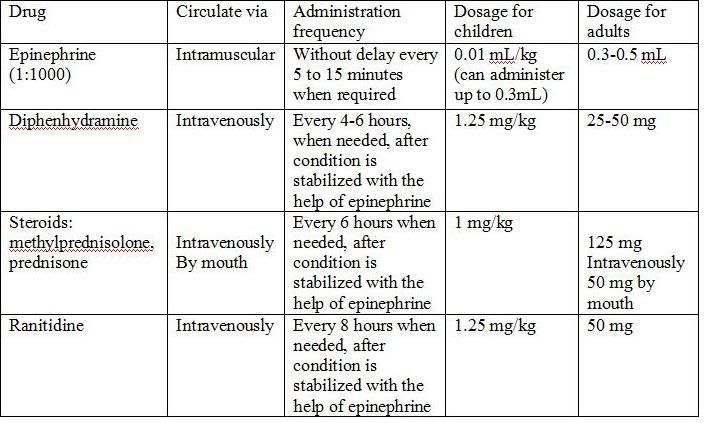 Table 1: Types of drugs, dosage required for child and adult. If symptoms of allergy still persist or the patient experiences breathing difficulties and hypotension, re-injection of epinephrine should be conducted once every 5-15 minutes until signs of hyperadrenalism[1] cease. The signs include palpitations (rapid and irregular heart beat), tremor, uncomfortable apprehension and anxiety. 1:10 000 dilution of epinephrine should be administered ONLY in severe hypotensive shock as it may be potentially harmful. Airway should be adequate and maintained for patients with anaphylaxis allergy reaction. Sufficient amount of oxygen should be given. 2. UNRESPONSIVE AFTER TREATMENT If the patient is not responsive to the treatment (epinephrine, antihistamines or steroid), there are three treatments that can be given to the patient depending on the condition. The three treatments are bronchodilators, nebulised adrenaline and vasopressors. Bronchodilators are given when the patient experiences persistent bronchospasm[2]. However if the bronchospasm continues, intubation will be necessary. Intubation can be accompanied by continuous puffs of salbutamol through aerosol port directly into the ventilation circuit which may have to ease the difficulty in breathing during bronchospasm. Nebulised adrenaline 5 mg in 5 mL together with parenteral adrenaline may be given when persistent stridor[3] occurs. Surgical airway intervention may be required if stridor continues. Vasopressors such as metaraminol or vasopressin may be prescribed when persistent hypotension[4] occurs. Persistent hypotension may be due to cardiac failure. Phosphodiesterase inhibitor such as glucagon may be given to patients who have pre-existing heart failure or are taking β-blockers. 3. POST TREATMENT Patients are not encouraged to be discharged as further observations of the patients are required. If they are discharged, there should be adequate supervision at home. They should have easy access to emergency medical response at home, in case anaphylaxis relapses. 4. LONG TERM MANAGEMENT Venom immunotherapy[5] can help to prevent allergy due to insect stings. It will help to lessen allergy reactions induced by stings. Long term treatment of anaphylaxis includes getting professional help from medical specialists on allergy profile and progress of illness, enquiring on the causes of anaphylaxis. Patients should avoid allergens that may trigger anaphylaxis. Common triggers of anaphylaxis include food, stinging insects and medication (as mention above in the mechanism of anaphlaxis). Food allergens may be avoided by reading labels on food packaging before consuming the food. It is important to know that treatment and medications may complicate management of anaphylaxis. Patients should learn more about the treatment given to them and try to stick to the treatment process. Patients should learn to identify early warning symptoms of anaphylaxis and develop an action plan if anaphylaxis is to occur. DEFINITIONS: 1. Hyperadrenalism is the state in which there is an excessive amount of adrenal hormones in the body. Symptoms depend on the hormone involved and the degree of involvement. 2. Bronchospasm is an abrupt constriction of muscles in the walls of the bronchioles. It is due to the release of substances from mast cells or basophils under the influence of anaphylatoxins. It causes very mild to severe difficulty in breathing. 3. Stridor is a term that describes noisy breathing produced by turbulent airflow through a narrowed segment of the airway. It usually originates from the larynx (voice box) or trachea (windpipe). 4. Hypotension is the condition of having unusually low blood pressure, 90/60 or lower, on a regular or semi-regular basis. 5. Venom immunotherapy is the process whereby venom is injected to treat various medical conditions. The most common form of venom immunization is bee venom therapy (BVT), with venom or stingers used to treat conditions. Y 6:00 PM References 1. Health Grades, Inc. October 21, 2008. Treatments for Hyperadrenalism. Thursday, Feburary 4,2009. url: http://www.wrongdiagnosis.com/h/hyperadrenalism/basics.htm 2. Harold Pine. Tubes and Tonsils. Thursday. Feburary 4,2009 url:http://www.tubesntonsils.com/Stridor.html 3. Paulla Estes . 2003. What is Hypotension.Thursday, feburary 4,2009url: http://www.wisegeek.com/what-is-hypotension.htm 4. Liz Swain. Alternative Medicine Encyclopedia: Venom Immunotherapy. Retrieved: Thursday, feburary 4, 2009. Url: http://www.answers.com/topic/venom-immunotherapy 5. eMedicine. Oct 6, 2008. Anaphylaxis. Retrieved: Tuesday, Feburary 2, 2009. url: http://emedicine.medscape.com/article/756150-overview 6. EpiPen. Anaphylaxis Causes - Information from EpiPen. February 5, 2009. url: http://www.anaphylaxis.com/pro/6_2.cfm 7. Dr Martin Stern. May 4, 2003. Anaphylaxis - Life-threatening allergy. February 6, 2009. url: http://www.users.globalnet.co.uk/~aair/anaphylaxis.htm#SEC3 8. Simon G A Brown, Raymond J Mullins and Michael S Gold. 2006. Anaphylaxis: diagnosis and management. February 4, 2009. url: http://www.mja.com.au/public/issues/185_05_040906/bro10212_fm.html |
About Us  Sharna
Sharna Jocelyn 
Tasniyyah  Elizabeth
Elizabeth Poh Li
Poh Li Ying Hui
Ying HuiComments From Temasek Polytechnic Applied Food Science & Nutrition February 2009 Love in the Ice - 東方神起 thanks basecodes by: detonatedlove/♥s} images: deviantart designer: ٩͡๏̯͡๏)۶ |
